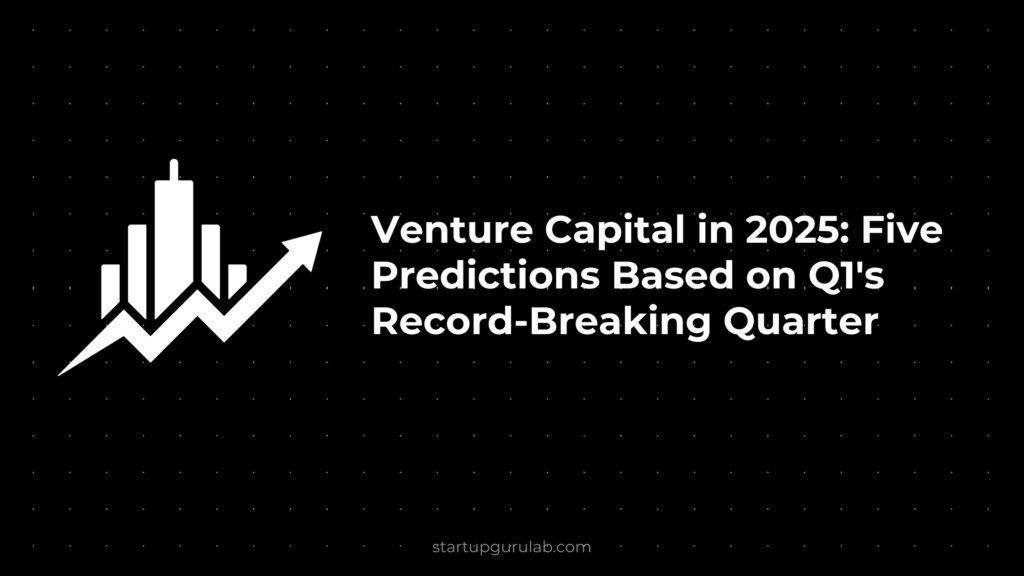- What is Business as Usual (BAU)? - October 8, 2025
- How Slack Grew to 10M Users Without Ads: Complete Growth Blueprint - October 8, 2025
- Top Startups in Kerala 2025 - September 26, 2025
The first quarter of 2025 has sent shockwaves through the venture capital ecosystem. With an eye-popping $121 billion deployed globally—despite fewer deals overall—we’re witnessing what might be the most significant restructuring of startup funding in years.
Based on CB Insights’ comprehensive Q1 Venture Report, I’ve analyzed what these unprecedented three months might tell us about venture capital’s trajectory for the remainder of 2025. Here are five predictions that founders, investors, and industry watchers should keep on their radar.
AI Will Capture the Lion’s Share of Venture Dollars, Creating a Two-Speed Startup Economy
If you’re not paying attention to AI’s growing dominance in venture funding, you might as well be ignoring a Category 5 hurricane on the horizon. Q1 data shows AI companies secured an unprecedented 20% of all venture deals—double their share since ChatGPT burst onto the scene in 2022.
This isn’t just another hype cycle—it’s a fundamental shift in where smart money is flowing.
By December, AI startups will likely command 25-30% of all venture deals and potentially 60% of total funding. When you look at OpenAI’s staggering $40B raise and Anthropic’s $3.5B round in just one quarter, it’s clear investors are making increasingly concentrated bets on AI market leaders.
For founders, this means navigating a bifurcated funding landscape:
- AI companies: Larger rounds, higher valuations, less traction required
- Non-AI startups: Greater scrutiny, clearer paths to profitability needed

$100M+ Early-Stage Round Will Become Standard for Elite Startups
Q1 2025 set an all-time record for early-stage companies raising $100M+ rounds, with eight such deals totaling $1.8 billion. Isomorphic Labs’ $600M Series A and Lila Sciences’ $200M seed round weren’t outliers—they’re harbingers of a new normal.
By year’s end, approximately 15% of all Series A deals could exceed $100M, concentrating primarily in three sectors:
- AI and machine learning
- Advanced biotechnology
- Climate tech infrastructure
For founders building in these spaces, this shift fundamentally alters the traditional startup journey. Elite companies can now bypass traditional growth stages, immediately building at scale and outpacing competitors who raise conventional rounds.
For investors, the implications are equally significant—fewer opportunities to invest at modest valuations and increased pressure to identify breakthrough companies at formation stage, often pre-product.
Corporate Venture Capital Will Roar Back to Prominence
Corporate venture capital has maintained a relatively modest profile since the pandemic, participating in just 7% of all deals in Q1. But beneath this seemingly stable figure, tectonic shifts are underway.
Google’s record-shattering $33B acquisition of Wiz (the largest private tech acquisition ever) and its $1B investment in Anthropic signal renewed corporate determination to secure technological advantages at any cost.
CVC participation will surge to 12-15% of all deals by Q4, driven by:
- Big Tech’s race to secure AI capabilities and talent
- Financial institutions hedging against fintech disruption
- Healthcare giants pursuing biotech and digital health innovations
- Record corporate cash reserves seeking returns beyond buybacks
US Venture Dominance Will Reach Historic Levels
The geographical distribution of venture capital in Q1 was nothing short of stunning: US startups captured $90.5B (75% of global funding) while representing only 39% of deals. In AI, this imbalance was even more dramatic, with American companies securing an astounding 91% of funding.
This isn’t just about money—it’s about where innovation is being bankrolled and, consequently, where it will flourish.
By Q4 2025, US startups could potentially capture 70-80% of global venture dollars. Multiple factors are driving this concentration:
- Policy uncertainties in China deterring investment
- Regulatory complexities in Europe creating friction
- The gravitational pull of the US AI ecosystem
- Silicon Valley’s unmatched network effects
For international founders, this presents tough choices. Many will feel increasing pressure to relocate to the US to access this capital advantage. Regional startup ecosystems will need to develop specialized niches where they can remain competitive despite the overall funding imbalance.
Venture Market Will Split into Mega-Rounds and Micro-Rounds, Squeezing the Middle
Perhaps the most consequential trend emerging from Q1 data is the barbell distribution forming in the venture market. Consider these statistics:
- 145 mega-rounds ($100M+) captured 70% of all funding
- Early-stage rounds reached a record median size of $2.7M
- Mid-sized rounds (Series B/C between $15-50M) are becoming increasingly scarce
By the end of 2025, this divergence will likely intensify further, creating three distinct paths for startups:
- The mega-funded: Companies demonstrating exceptional traction raising $100M+ rounds
- The capital-efficient: Startups operating leanly with modest early funding ($1-10M)
- The squeezed middle: Companies caught between these extremes, facing existential funding challenges
For founders, this evolution demands strategic clarity from day one—either building with extreme capital efficiency or positioning for the metrics needed to secure mega-rounds.
What This Means for the Rest of 2025
These predictions point to a venture landscape that’s becoming simultaneously more concentrated and more stratified. Founders face a paradoxical environment: record amounts of capital are available, but accessing it requires either extraordinary traction or positioning in favored sectors like AI.
For investors, successful navigation of this environment will require:
- Greater specialization in specific verticals
- Earlier access to elite companies
- Comfort with both extreme concentration in certain bets and broader diversification across capital-efficient startups
The remainder of 2025 will determine whether these Q1 trends represent a new equilibrium in venture capital or merely another phase in the market’s ongoing evolution. Either way, the rules of the game have changed significantly, and all participants will need to adapt to this new reality.
For founders raising capital in 2025, the message is clear: understand which side of these divides you fall on, and craft your fundraising strategy accordingly. The middle ground is disappearing fast.

